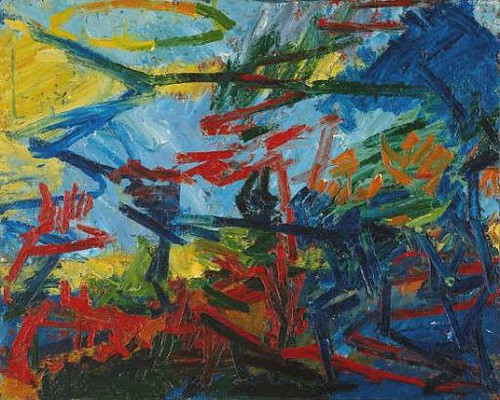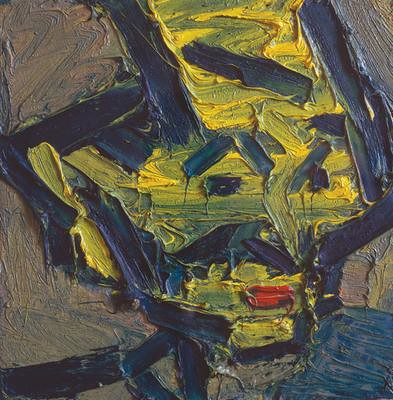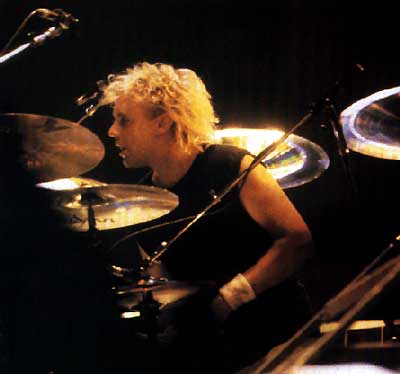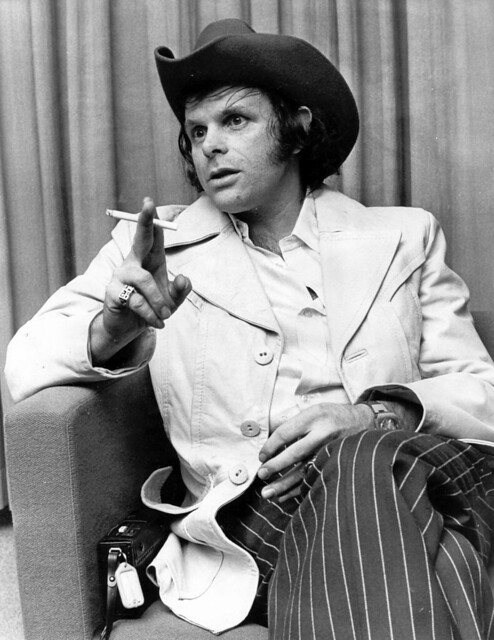
Head of Catherine Lampert
 Auerbach, Frank (1931- ) - 1971 Bacchus and Ariadne
Auerbach, Frank (1931- ) - 1971 Bacchus and Ariadne
Auerbach, Frank (1931- ) - 1971 Head of Gerda Boehm

Frank Auerbach
Frank Auerbach, has been described as a "painterly genius" and as "one of the most impressive painters living today". When describing Frank Auerbach's great retrospective show at The Royal Academy in 2001, David Sylvester of 'The Listener' declared it "The most exciting and impressive first one-man show by an English painter since Francis Bacon in 1949." Frank Auerbach's other major shows include his first retrospective (1978) at the Hayward Gallery, London, The Venice Biennale (1986), where he won the Golden Lion prize and the National Gallery (1995), where he presented drawings made over a thirty-year period from his paintings that preside in the National gallery's collection. Frank Auerbach's work is also in the permanent collection at the Tate Gallery.
Frank Auerbach is first and foremost a figurative painter, his subjects are almost always either his wife Julia, Juliet Yardley Mills (referred to as 'J.Y.M' in titles) or his friend and lover, Stella West (generally known as "Stella" but referred to as "E.O.W" in his works). Living an almost hermit like existence; sleeping and working in his studio all week translates into Frank Auerbach's landscape works almost always being of scenes that are close to his studio and home in Camden, London. Famous landscape works include 'Morning Crescent' and 'Primrose Hill'. As described by John O'Mahony in the Guardian "Auerbach manages to unleash a heaving torrent of imagery, spun out of the heaviest, most tactile masses of paint ever flung at canvas".Frank Auerbach was born in Berlin in 1931. He was sent to England, by his parents, to escape the Nazi's in 1939. His parents were later to perish in a concentration camp.[3]As part of the Kindertransport programme; Frank Auerbach attended Bunce Court, a boarding school for refugees. His artistic talents and 'expressionistic' style did not go unnoticed and he was soon heralded an artistic prodigy. Sponsored by the writer Iris Origo, Auerbach went on to study at St Martin's School of Art and later at the Royal College of Art.
Frank Auerbach was also a talented actor and it was at the age of 17, while playing a bit part in Peter Ustinov's first play 'House Of Regrets' that he met the 32 year old Estella Olive West (E.O.W), a widowed amateur actress who ran a boarding house in Earls Court. She would be his lover for the next 23 years. (Including after his marriage to J.Y.M). With her, Frank Auerbach established his pattern of working and reworking paintings, so that some works took hundreds of sittings to complete: "It was quite an ordeal, because he would spend hours on something and the next time he came he would scrape the whole lot down. That used to upset me terribly. I wondered what I was doing it all for." Their relationship was "often fraught, occasionally bordering on violence"; both agree that the violence was mainly Stella's, but that his work captured that intensity.
Frank Auerbach's style of work is best described by John O'Mahony from the Guardian "Frank Auerbach does not prepare underpaintings, nor does he use outline sketches for portraits, and he relies on his sitters being able to reassume the same pose session after session. In contrast, he sketches landscapes in the field and brings the sketches back to the studio, sometimes using as many as 200 sketches for a single painting.
Frank Auerbach's work might broadly be described as expressionist. Many of his paintings display an extremely thick impasto, something which he was criticised for at his 1956 Beaux Arts solo show, where some of the paintings were displayed flat rather than hanging, for fear that the paint would fall off from its own weight. The impasto, which grew even heavier over the next decade (but later decreased, as he began scraping down his paintings more as he worked), is sometimes so heavy that the paint seems to have been sculpted rather than brushed on.
A similarly sculptural aspect can often be found in his drawings: Auerbach layers multiple sheets of paper as much as half an inch in thickness and in some parts of the drawing he may erase so heavily as to go through several sheets. This can be readily seen in the area surrounding the upper part of the head in his 1960 Head of Julia. The extreme predominance of earth colours in his early work was largely a matter of budget: a £1,500 annuity from the Beaux Arts allowed him to broaden his palette, which can be seen in his works once he resumed painting. Colours such as aquamarine and cadmium red began to appear in his paintings. The gallery guide to the 2001 Royal Academy retrospective says that "The physical effort required to produce the large works is enormous. Painting the ultimate version of the composition, laid over the scraped-off remains of so many predecessors, frequently demands six or more hours of intense activity." Similarly, in discussing one of his paintings of Primrose Hill, "Reading an Auerbach painting is an energetic experience… Furiously worked pink vibrates in a different way to swift interlinked zigzags of red and green, while a marbled sky offers an area of tranquillity."
Frank Auerbach was taught by David Bomberg who in turn was taught by Walter Sickert and so on in an unbroken linage that leads via Degas, Ingres and others right back to Giulio Romano and Raphael. Say artist Tom Phillips "The message handed down is always the same: that, in the words of Ingres, drawing is the probity of art. Frank Auerbach is today the passionate exemplar of this hard and glorious truth."
The obsessive intensity that Frank Auerbach gives to his paintings and drawings is also evident in his startling etching and drypoint prints. Frank Auerbach's skills as a print maker started when he was still a student at the Royal College of Art. Based on six life drawings chosen from several hundred made over the previous few years, these prints were executed in the most direct means possible. As described by Craig Hartley in 'Frank Auerbach Etchings & Drypoints 1954-2006' "Taking a nail set into a pen-holder, he redrew the figures on pieces of zinc alloy, scratching the lines, pressing ink into the scratches, and then printed them by laying over a sheet of dampened paper and rubbing the back with a spoon." The marks of rubbing with the spoon are clearly visible in the background of these earliest prints. The 1954 series of drypoint etching prints are: 'Reclining Nude' State I (before all the hatching in the background). State II (with hatching and inscribed 20/20). Both signed bottom right Auerbach. 'Nude seated on a Low Chair'. State I (before all the hatching at the bottom and behind the back). State II (with this hatching). Both signed bottom right Auerbach. 'Nude Seated with Arms above her Head', signed bottom right Auerbach. 'Standing Figure'. State I (before table and teapot added to the left of the figure, before vertical line rising above shoulder on left, and before horizontal hatching to the right of legs). State II (with this additional work, in a private collection). State III (with table and teapot removed). Signed bottom left Auerbach. 'Nude Seated on a Folding Chair'. State I (before all the hatching in the background and before the angle of figure's right shoulder altered). State II (with this hatching and alteration). Signed and dated bottom left Auerbach. 'Nude in Profile' State I (not located but presumed from artist's inscription on second state). State II (before shading on right thigh). State III (with this shading). Signed top left Auerbach. Craig Hartley goes onto say "For Auerbach, the process of redrawing a subject is always one of rethinking and reformulation, and in this case the move from one medium to another, from charcoal drawing to drypoint print, involved shifting the modulations of shading and volume. But something of the richness of the charcoal line is retained by the soft burr of ink trapped by the rough edges of the scratched line."
1966 saw the experimental screen print 'Playing Cards-Two Heads of JYM', edition size 70 and in 1971 the emergence of 'Recumbent Woman', edition size 70. Signed Auerbach
As in his paintings, which involves repeated sittings over a period of time, scraping back and overpainting until the whole can be repainted in one final summation of the total experience. In Frank Auerbach's printmaking the sense of revision and accumulated layers of observation has found equivalent channels.
This sense of layering emerges strongly in his next pair of etching prints, the only two landscape prints Frank Auerbach has done. Unusually the landscape does not involve the surroundings of his home turf Camden Town, but were drawn directly from frequent visits to house in Tretire Herefordshire. Frank Auerbach made many drawings looking out of an upstairs window of a large tree seen from above, putting out food to entice the chickens into a more prominent position. Instead of going back to the studio to etch the plates he preferred instead to take them back to Tretire and etch direct from the subject. After much regrouding and reworking the idea of adding a layer of screenprint emerged. The lines on the screen were drawn from life on the same scale as the plate. In each print, the difference of breadth and quality between the etched marks and the screenprint creates a sense of layering. The pair of etching and screenprint prints were published in 1975-1976 and are: 'Tree at Tretire I' edition of 30, signed in pencil Frank Auerbach bottom right, dated 1975 and inscribed to James. And 'Tree at Tretire II' edition of 30, signed in pencil Frank Auerbach bottom right, dated 1976.
The first double plate etching occurred in the first set of Frank Auerbach's two sets of portrait heads. 'Six Etchings of Heads'. All six portraits are of his old friends and fellow artists. To draw on the plates he used a dart (bought from his local Woolworths): he had learned that almost anything would do to draw into the etching ground, and, as in his earliest drypoints, he did not want to be encumbered with anything but the simplest and most available means. This series of six etchings published in 1980 are: 'Joe Tilson', signed in pencil bottom right Auerbach, edition size 50. 'R.B. Kitaj', signed Auerbach bottom right, edition size 50. 'Leon Kossoff' signed Auerbach bottom right, edition size 50. 'Lucian Freud', signed Auerbach bottom right, edition size 50. 'Gerda Boehm', signed Auerbach bottom right, edition size 50. 'Julia', signed Auerbach bottom right, edition size 50. The plate of 'Kitaj' used two stages of biting, each with a different acid to create two distinct qualities of line, while 'Kossoff' went a stage further and used two plates, each linked in a different colour (black and grey).The head of 'Lucian Freud' used as many as four different plates, creating a more tonal effect. 'Boehm' goes back to the simpler single-plate line of Tilson, while the line in the plate of 'Julia' is altogether more delicate, recalling the gentle, quizzical paintings that Auerbach was making of her at this time. As Craig Hartley goes on to say in 'Frank Auerbach Etchings and Drypoints 1954-2006' "Each adaptation of etching seems to respond to the character as much as the form of the sitter."
It was to be nearly ten years before Frank Auerbach made his next series of etchings. 'Seven Portraits'. These too were to feature family, friends and acquaintances who had already sat for him. This time Auerbach's chosen tool at his local Woolworths was a screwdriver rather than the dart used for the previous series of etchings. The screwdriver enabled him to vary the width of the drawn lines, rather like the traditional etching tool known as an echoppe. The length of biting of plates in the acid also affected the line. 'Julia' is more lightly bitten than the rest, while 'J.Y.M' was bitten for much longer, with bolder and more imposing lines that suit this model. Most heavily bitten of all was the etching print of his son 'Jake'. After being bitten for four-and-a-half-hours Auerbach then added more work and had it bitten for a further nine hours. The results are these extraordinary rich and encrusted lines, one of the finest examples of the closeness to the impasto of paint you are ever likely to see.
The 1989-90 'Seven Portraits' series of etching prints are: 'Julia' edition of 50, signed bottom right in pencil Auerbach. 'David', edition size 50, signed bottom right in pencil Auerbach. Both of these prints were made for inclusion with a copy of the 'de-luxe' edition of the book by Robert Hughes 'Frank Auerbach' London 1990. 'Catherine' edition of 50, signed bottom right in pencil Auerbach. 'J.Y.M' edition of 50, signed bottom right in pencil Auerbach. 'Michael' edition size 50, signed bottom right in pencil Auerbach. 'Geoffrey' edition size 50, signed bottom right in pencil Auerbach. 'Jake' edition of 50, signed bottom right in pencil Auerbach.
Many of Frank Auerbach's prints to appear between 1994 and 2001 are of his wife Julia and share an intimacy of feeling. Most are of her reclining, which was less tiring what with so many sittings! There is an unintended similarity of spirit to some of Rembrandt's repeated studies of his sleeping wife Saskia. These etching prints include: 'Julia' 1994, edition size 35, signed in pencil bottom right Auerbach. 'Julia' (Reclining head of Julia) 1998. State I: proof before engraved lines added at bottom. State II: Published state. Artist's proof of second state outside the published edition of 35 (titled as Reclining head of Julia), signed in pencil bottom right Auerbach. 'Julia' 1998 etching and aquatint print, printed from two plates in black and gold. State I: with etched inscription 'Julia' and lines in background. State II: with inscription and lines removed. Edition size 35, signed bottom right in pencil Auerbach. 'Julia Asleep' 2001, etching and aquatint print, printed from two plates in gold and black, edition size 35, signed bottom right in pencil Auerbach. 'Julia' 2001, etching printed from two plates black and silver-grey. Made for the inclusion with a copy of the 'de-luxe' edition of the Royal Academy exhibition catalogue 'Frank Auerbach Paintings and Drawings 1995-2001', edition size 35, signed in pencil bottom right Auerbach. 'Sleep' 2001, edition size 35, signed bottom right in pencil Auerbach.
The other main subject featured in his prints at this time was Ruth Bromberg, who like Julia was a regular weekly sitter. For these etchings of Ruth, Frank Auerbach expanded the plates, not only revelling the figure beyond the confines of a portrait head, but also in the breadth of the lines. Using aquatint for the first time, this allowed the depth and new breadth of Auerbach's lines to bite sufficiently whilst still retaining the delicacy of the finer lines. As described by Craig Hartley in 'Frank Auerbach Etchings & Drypoints' "This range of mark-making, in tandem with the use of plates in different colours, and the strong diagonals of the pose, brings an almost Baroque richness." These prints are: 'Ruth' 1994, etching and aquatint prints with two plates black and grey, edition of 30, signed in pencil bottom right Auerbach. 'Ruth II' 1994, etching and aquatint printed from two plates black and grey, edition of 30, signed in pencil bottom right Auerbach. 'Ruth' 2001, etching. State I: proof before second biting. State II: published state. Edition size 35, signed bottom right in pencil Auerbach. 'Ruth' 2006, was the largest print to date. An etching and aquatint with engraving. State I: proof before engraved lines added on lips. State II: published state. Edition size 35, signed bottom right in pencil Auerbach. The appearance of this print is startling, partly for its scale, almost life size, but also for the boldness of its marks.
2006 also saw the publication of 'Jake', an equally brilliant etching, made in a similar way to 'Ruth'. In both these prints they feature the broadest marks found in any of Auerbach's etchings since the screenprint layers in 'Tree in Tretire'. 'Jake 06' etching and aquatint print is an edition size 35 and signed bottom right in pencil Auerbach.
Frank Auerbach may have been less than comfortable with the medium of printmaking, but comfort was something he mistrusted and plays no part in his art. Printmaking suits an artist who values the effort involved, and the traces of effort surviving in the print. Printmaking also attracts Frank Auerbach for more metaphysical reasons, for the transfiguring effect that it can bring. In his own words: "The graphic mark which was made spontaneously, quickly, and then by some magic turns into a form of permanence that can be stamped down - no other medium has got that. And to me it is a tremendous magic that something that could have been done in 20 minutes is persevered not as a sketch, but as something of more permanence and authority."
Frank Auerbach declined a knighthood in 2003.








 43
43 24
24 9
9

